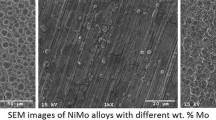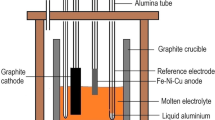Abstract
Multisweep cyclic voltammetric (CV) responses of nickel, copper, Monel and nickel–copper alloy had been extensively studied and compared in different non-aqueous solvents, such as acetonitrile (AN), propylene carbonate (PC) and sulpholane-containing anhydrous hydrogen fluoride (AHF) medium in the absence and the presence of triethylamine (Et3N). The quantity of dissolution and surface morphological transformation on the electrodes as a result of anodic polarisation were investigated by means of atomic absorption spectroscopy and scanning electron microscopy (SEM), respectively. The CV study indicates that Ni, Cu and their alloys are highly unstable in AN/AHF medium. Surface morphology of Ni after polarisation in this medium reveals the generation of number of pits, whereas the evolution of small crystallites of CuF2 is noted on the polarised alloy material, as evidenced by SEM pictures. The dissolution characteristics decrease significantly in PC/AHF medium and become low in sulpholane-containing fluoride medium on the four electrodes. The relative solubility of metal fluoride film in the three solvents increases in the order: sulpholane < PC < AN. The voltammograms suggest that addition of Et3N (0.5 M) to AN- and PC-containing AHF medium helps both in maintaining uniform dissolution and generating compact fluoride film on the electrode surface. The addition of Et3N to AHF/sulpholane medium shows only little influence in improving the electrocatalytic oxidation process.









Similar content being viewed by others
References
Alsmeyer YW, Childs WV, Flynn RM, Moore GGI, Smeltzer JC (1994) In: Banks RE, Smart BE, Tatlow JC (eds) Organic fluorine chemistry: principles and commercial applications. Plenum, New York
Childs WV, Christensen L, Klink FW, Koplin CF (1991) In: Lund H, Baizer MM (eds) Organic electrochemistry, 3rd edn. Marcel Dekker, New York
Chambers RD (2004) Fluorine in organic chemistry. Blackwell, Oxford
Jayaraman K, Noel M (2001) Bull Electrochem 17:227–238
Yonekura M, Nagase S, Baba H (1976) Bull Chem Soc Jpn 49:1113–1116
Shodai Y, Inaba M, Momota K, Kimura T, Tasaka A (2004) Electrochim Acta 49:2131–2137
Tasaka A, Yachi T, Makino T, Hamano K, Kimura T, Momota K (1999) J Fluor Chem 97:253–261
Tasaka A, Nakanishi K, Masuda N, Nakai T, Ikeda K, Momota K, Saito M, Inaba M (2011) Electrochim Acta 56:4335–4343
Matalin VA, Kaurova GI, Moldavskiy DD, Barabanov VG, Blinova OV (2003) Fluor Notes 6:31–35
Matalin VA, Kaurova GI, Berenblit VV, Gribel VI (2007) Russ J Appl Chem 80:2090–2092
Ilayaraja N, Velayutham D, Noel M (2009) J Fluor Chem 130:656–661
Dimitrov A, Rudiger S, Seppelt K, Peplinski T (1994) J Fluor Chem 69:15–19
Rudiger S, Dimitrov A, Hottman K (1996) J Fluor Chem 76:155–160
Sartori P, Ignat’ev N, Datsenko S (1995) J Fluor Chem 75:157–161
Sartori P, Ignat’ev N (1998) J Fluor Chem 87:157–162
Drakesmith FG (1997) Electro fluorination of organic compounds. Springer, Berlin
Sing YL, Lee LF (1985) J Org Chem 50:4642–4646
Lee LF, Stikes GL, Sing YL, Miller ML, Dolson MG, Normansell JE, Auinbauh SM (1991) Pestic Sci 31:555–568
Parker MH (2004) Synth Commun 34:903–907
Haruta M, Watanabe N (1976) J Fluor Chem 7:159–177
Rozhkov IN, Bukhtiarov AV, Knunyants L (1969) Izv Akad Nauuk SSSR Ser Chem 4:945–947
Bulan A, Herzig J (2004) US Patent: US 6752917
Qian SY, Dumont H, Conway BE (1997) J Appl Electrochem 27:1245–1253
Noel M, Suryanarayanan V, Krishnamoorthy S (1995) J Fluor Chem 74:241–246
Noel M, Suriyanarayanan N, Suryanarayanan V (2001) J Solid State Electrochem 5:419–430
Suriyanarayanan N, Noel M (2008) J Solid State Electrochem 12:1453–1460
Sathyamoorthi S, Velayutham D, Suryanarayanan V, Noel M (2011) Electrochim Acta 56:7012–7021
Calandra AJ, DeTacconi NR, Perevio R, Arvia AJ (1974) Electrochim Acta 19:901–905
Noel M, Vasu KI (1990) Cyclic voltammetry and the frontiers of electrochemistry. Oxford-IBH, New Delhi
Clifford AF, Sargent J (1957) J Am Chem Soc 79:4041–4045
Isogai T, Nakai T, Inoue H, Nakanishi K, Kohara S, Saito M, Inaba M, Tasaka A (2011) J Phys Chem B 115:9593–9603
Acknowledgments
The authors thank Director, CSIR-CECRI, Karaikudi for his keen encouragement in publishing this work. Financial support from DRDO, New Delhi is greatly acknowledged. Thanks are due to Dr. R.P. Singh and Dr. Raju Brahma, CFEES, DRDO, New Delhi for their fruitful discussions.
Author information
Authors and Affiliations
Corresponding author
Rights and permissions
About this article
Cite this article
Sathyamoorthi, S., Saravanan, K., Velayutham, D. et al. Influence of triethylamine on the anodic dissolution characteristics of Ni, Cu and their alloys in non-aqueous solvents containing fluoride media: voltammetric and surface morphologic study. J Appl Electrochem 42, 595–606 (2012). https://doi.org/10.1007/s10800-012-0436-y
Received:
Accepted:
Published:
Issue Date:
DOI: https://doi.org/10.1007/s10800-012-0436-y




